|

|
|
Oviraptor philocerataps (Andrews, 1924) |
|
 |
|
Name Means: |
"Egg Robber" |
Length: |
6 feet (2.5 m) |
|
Pronounced: |
O-vih-Rap-tor |
Weight: |
70 pounds (30 kilos) |
|
When it lived: |
Late Cretaceous - 67 MYA |
|
|
|
Where found: |
Mongolia, China |
|
|
|
Roy Chapman Andrews was
a legendary and adventurous paleontologist. Some say that the
movie character Indiana Jones was based on him. In the 1920s, he led an expedition into Mongolia that uncovered some amazing dinosaur
fossils. One day the expedition photographer, James B. Shackleford,
discovered a plant-eating dinosaur called Protoceratops . Later
a technician named George Olsen found a nest of eggs close by that
contained the bones of another dinosaur on top of the nest. He assumed
that the eggs belonged to Protoceratops , but the bones
associated with this nest were those of a meat-eating dinosaur.
Because Protoceratops was a plant eater, he concluded that this
new, previously unknown, dinosaur was stealing the Protoceratops eggs from the
nest, and because of this it was named Oviraptor, which means egg
thief.
Many years later Dr. Philip Currie and a team of
paleontologists uncovered another nest in Inner Mongolia and surprise,
it contained Oviraptor bones on top of the nest as well.
Another Mongolian expedition the following year even found parts of a
tiny baby dinosaur skeleton (embryo) inside the same kind of egg.
When they began to study these embryos they were surprised to learn
that they were actually from an Oviraptor, and not Protoceratops
.
This discovery completely changed the world's view of Oviraptor.
Dr. Currie and many other dinosaur hunters believe that the adult that was
found with the nest was actually a mother or father Oviraptor
sitting on the nest, much like a mother chicken does, to protect
the eggs. Mongolia has very bad sandstorms, so it is now thought that
the mother was protecting the eggs during a severe sandstorm that
buried them. Dr. Currie and other scientists believe that this
discovery is strong evidence that Oviraptors were excellent
parents and that they cared for their young, much like modern birds.
In addition to being good parents, scientists now believe that
Oviraptors were also very particular about how they built their
nests and laid their eggs. It appears as though Oviraptor
nests had more than one layer and that the eggs were arranged in a
spiral pattern. Dr. Currie believes that Oviraptor laid its
eggs while turning in a clockwise circle. She laid two eggs at a time,
then turned to the right and laid two more. The mother Oviraptor
also might have used her hands to scoop sand on the eggs as she laid
them. The nest probably ended up looking like a mound of sand. Not all
dino hunters agree, but this is one theory.
Oviraptor is a very unique dinosaur with some rather strange
features. Instead of teeth it has a beak and something not seen in any
other dinosaur, two teeth in the roof of its mouth. The reason it got
its name is that when it was first discovered Oviraptor was
sitting on a nest of eggs. It was thought it was stealing the eggs of
another dinosaur. Years later, it was found that the eggs were its own
and that it was trying to protect them from an approaching sandstorm.
Oviraptor has another unusual feature - it has a thin crest of
bone on its forehead. This crest seems to have grown and changed
throughout its entire life. It may have been used as a form of
individual identification or to differentiate gender. Also, different
species of the Oviraptor genus had different crests. It is not
clear what Oviraptor ate. Since it was probably not eggs, and
it had very strong jaws, some think it would have eaten shellfish that
it could easily crack open. Others argue that it must have been an
herbivore as its skull did not show characteristics for meat eating.
A North American
Oviraptor was discovered in 1996 in South Dakota. This specimen is
very large, almost 20 feet long. A trackway has also been associated
with this find. It has not yet been described, nor named. |
|
|
|
|
|
|
|
|
Edugraphics.Net | Feenixx Publishing |
|
|
|
|
|
![]()
